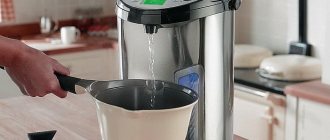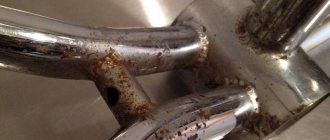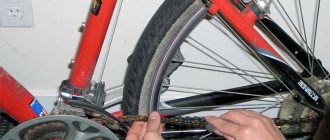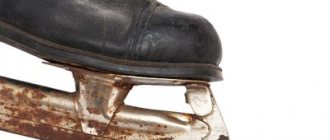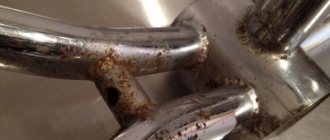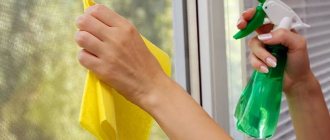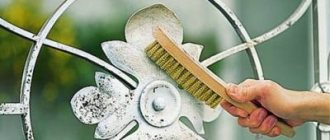by Alexey | Cleaning Tools | Friday, December 03, 2021
| Follow Make-Self.net on Facebook and be the first to read our articles. |
Rust is completely preventable, but it is often unavoidable if you have a large number of metal tools. Those tools that you left outside in the rain and snow are now unusable, but that doesn't mean you have to throw them away! There are several different methods you can use to clean rusty tools so they are ready for use.
Why do tools rust?
You want to clean rusty tools, but it's also important to understand how it happened in the first place. Rusty tools are the result of water remaining on the steel for a long period of time. Rust forms when oxygen and water react with iron . If a tool is constantly exposed to water and oxygen, rust can form within four or five days. If by the time you realize that your tools are rusty, corrosion has not yet set in (that's when holes start to form in the metal), you can still fix the situation by cleaning the rust off.
When it comes to removing rust, you have several options. Find out the best tips for removing rust from tools!
Special anti-corrosion agents
There are several special products that are produced to combat corrosive plaque.
Solvents
To remove rust from metal coatings, use Schnell-Rostloser. This cleaner has good qualities that allow you to get rid of traces of oxidation. You can also treat the iron product with Spirit-1 solvent. Its advantages include:
- displacement of moisture particles from iron;
- formation of a protective layer on the treated coating;
- cheapness.
See also
How to wash resin from your hands, TOP 8 products and prohibited methods
Converters
Converters are means that convert corrosion particles into a durable film. Such compositions are available in the form of solutions, emulsions and suspensions.
Experts recommend using converters not only to remove rust stains, but also to protect the product from further corrosion.
Cleaning with sandpaper
When using sandpaper to remove rust, you will need a little bit of effort, as well as coarse and fine grit sandpaper. Start by cleaning the tool of dirt and grease, then dry it completely . Once it's dry, take some coarse sandpaper and sand off any rust from the surface , then switch to a finer grit so you can smooth out any grooves or marks left by the coarse sandpaper. If sandpaper doesn't help remove deeper rust, you'll have to double down on one of the other methods for removing rust from tools.
Ways to unscrew rusty parts at home
Removal using a socket or spanner
If the rust layer is not too large, use a socket or socket wrench. In this case, the tool must have 6 or 12 contact points. Next, you need to alternately tighten and loosen the threads with fairly sharp movements. If this doesn't help, scrub the surface with a wire brush and then apply one of the lubricants mentioned above. Once the product has started to work, take a hammer and lightly tap the fastener to knock off the top layer. Then use the key again, the clamp should loosen. To enhance the effect, you can put a pipe on the wrench or use a tool without a ratchet with a long handle. But be careful when working, bad and old tools can break right in your hands.
Do not use brute force, otherwise the thread may be stripped.
Use muscle power and this tool
Exposure of nuts and bolts to high temperatures
Alternatively, you can use heat to remove the part. Take a blowtorch and heat the mount with it. It is important to heat only one side of the bolt or nut so that it expands from the heat and damages the rust layer. If you don’t have such a tool at hand, you can use an ordinary candle. After heating, pour cold water over the part, and then pick up the key again. The only disadvantage of such methods is that they spoil the hardening of the metal.
WD-40 and steel wool
WD-40 is a product specifically formulated to break the bonds between rust and the metal surface to which it is bonded. When you are trying to remove light surface rust from your tools, spray it directly onto the rusty area and let it sit for ten minutes . Once you've allowed the WD-40 to loosen the rust, take a piece of steel wool and scrape away the rust until the tool is clean. Wash the tool and dry it thoroughly before putting it back in the toolbox.
Traditional methods
Someone who is skeptical is ready to argue that it is unlikely that the situation with rust can be solved with improvised means, compounds that, as a rule, are found in every apartment. It turns out that it is possible. Many have independently tested these methods in practice, actively use them and share their knowledge with friends.
Baking soda
This product, which is present in all kitchens, can be safely added to the list of universal ones. In addition to cooking, it has proven itself excellent in removing stubborn stains from coffee, green grass, blood, and also in cleaning metal from rust. To prepare the composition you will need: baking soda and water . Taking into account the processing area and the degree of damage to the material, the required amount of ingredients is selected: the finished mixture should have a moderately thick consistency - store-bought sour cream.
Apply the mixture to the surface of the stain and leave for 25-30 minutes. This is the optimal time to remove a small amount of rust and after it has passed, it is enough to wipe the treated area with a damp cloth. The attempt was not very successful - then the procedure should be repeated, and in case of “overgrown” contamination, it is better to first use a metal scraper.
You should not place high hopes on this method if there is a large area of damage. But you can safely use it when you need to quickly, one-time get rid of a small spot of rust. Don't forget about other types of soda.
Baking and soda ash
The product is suitable for cleaning enamel bathtubs. baking soda and soda ash in a small amount of water in a 1:1 ratio (2-3 tablespoons is enough). Cover the affected area with the resulting mixture and leave for 1.5 hours. The next step is to apply 50 g of bleach and the same amount of vinegar on top. While waiting for the cleansing reaction, we leave all the products for another 0.5 hour, after which we wash everything off with warm water.
For those who have a cast-iron bathtub, you can use a mixture of soda ash and laundry soap (1:1). Rub the soap on a coarse grater, add soda, warm water, and bring the mixture to a homogeneous thick consistency. Apply the resulting paste to the damaged surface for 1-1.5 hours, then rinse with water. If the rust has not been touched for a long time, it has become old, then the proposed composition can be improved with the help of ammonia . Its quantity is the same as the other components. Let the renewed slurry sit on the rust stain for 1.5 – 2 hours, then wash off with warm water.
Caustic soda
You will have to work hard to prepare a solution that contains the specified alkali (caustic soda, sodium hydroxide), but it is worth it. To create the product we take: water - 300 ml, caustic soda - 50 g, formaldehyde 40% - 250 g, ammonium - 50 g . We dilute the resulting paste in 1 liter of water and lower the rusty parts into the ready-made solution. Cleaning time can vary from 15 to 30 minutes, since it directly depends on the degree of damage to the material. The final stage is rinsing generously in hot water and wiping dry. This method is good for removing rust from steel products.
Laundry soap and raw potatoes
Every housewife will be glad to quickly and without unnecessary problems remove small rust from the oven, baking sheet or stove. This is not difficult to do. Take raw potatoes, cut them in half, be sure to salt them and grease them with soap. We use the resulting part of the vegetable to eliminate the problem, like an abrasive sponge with an additional element - oxalic acid. Sometimes during the process you have to renew the cut, soap it and continue working, or you can leave part of the tuber on the corrosive area for 3-4 hours. Vegetable to cope with the task.
During the season, when potato tops are still green and juicy, they are used to create an anti-corrosion composition. Fill a 3-liter jar halfway with tops, add hydrochloric acid so that it just covers the greens. Stir the future inhibitor for 15-20 minutes, then drain, filter and you can treat “red” spots
Ketchup
Tomato sauce, paste or ketchup - with their help, any woman will conquer rust stains. The secret of the wonderful power of the products is quite simple: tomatoes contain a considerable amount of the same oxalic acid, which destroys rust. In addition, many preparations contain citric acid as a preservative, which only enhances the effect of its friend. Apply sauce, ketchup or juice to the surface with rust, wait 20-40 minutes, sometimes let it sit for a couple of hours. Then rinse and wipe dry. The method works successfully on the surface of the bathtub, and is also useful when cleaning cutlery (forks, knives, spoons) and other metal utensils.
Fish fat
Some craftsmen and car enthusiasts have made this useful product work for themselves. Fish oil is much more active than its fellow fats in dissolving the rust component – iron hydroxide. Under the influence of the first (1.5 - 2 hours), the rust softens and is quite easy to remove. In addition, penetrating well into the depths of the damage, fish oil forms a thin protective film that blocks the access of air, stopping the process of metal oxidation and destruction of the part.
When the problem, even a small one, but there is noticeable damage to the paintwork, a very fast and, at the same time, correct way to get rid of rust is needed. The best options are a rag soaked in kerosene , or a swab with a mixture of crushed charcoal and machine oil . The advantage of the latter is simultaneous cleaning and polishing of the surface
Pork fat
The method is old, but it will help keep metal tools clean and in good working order. Add camphor (2 g to melted pork fat (100 g , mix until smooth, carefully skim off the foam and add powdered graphite . Apply rubbing movements to the instrument and leave for 24 hours. Then we rub the tools with a woolen cloth and everything is in order.
Graphite powder in combination with some greasy product, for example, Vaseline , is an excellent anti-corrosion protection for threaded nuts, screws, etc. Even after a long stay outdoors, in snow or rain, the treated parts can be easily unscrewed
Paraffin
Another way to treat parts against corrosion. After all, the first thing that comes to mind when you hear the word rust is iron. Not quickly, but effectively, you can treat metal elements with a paraffin solution (saturated). Paraffin shavings are dissolved in a container with kerosene until saturated (maximum concentration). The solution will be ready after seven days. The part is kept in it for several more days and the rust is removed without any problems.
Coca Cola
World-famous sodas Coca-Cola, Pepsi, Sprite, Fanta are multifunctional drinks. They not only quench thirst well, but are often used to clean various surfaces and remove various stains and rust from them.
Do you want to clean the red stains from the drain tank? Please. Take: 2 liters of Coca-Cola, 450 g of soda, 120 g of citric acid and 45 ml of vinegar , mix everything and pour it into the tank overnight. In the morning you will have to work a little with an old toothbrush to clean small parts, and then simply rinse the entire structure inside with water.
Having picked up Cola, you need to know that if the surface is chrome or sanitary ware, then there will be no problems with cleaning, but if the rust is directly on the iron surface, then you will have to tinker and make an effort
It is also possible to stop the destructive process on coins and cutlery. Place small items in pre-prepared dishes, fill with soda, and leave for two days. The degradation of the material will be much reduced; if necessary, the process can be easily repeated again.
More than once men have encountered such a problem as “stuck” rusty bolts. And you need to unscrew them. Therefore, we take a cloth, soak it well in the drink and wrap it around the part itself or the entire fastener so that the liquid, by any means, slowly gets inside the fastener. Phosphoric acid will do the trick.
"Alka-Seltzer"
The analgesic drug copes well with such a problem as rust. The explanation for this is the composition of the drug: two types of acids (citric, acetylsalicylic) and sodium bicarbonate (baking soda). To ensure that all the ingredients work in the right direction, crush the tablet and add just a little water to get a “mush”. Apply the resulting mixture to the rust stain, wait for some time (possibly up to 2 hours), and remove the residue with a sponge or cloth.
If cutlery or small parts need cleaning, then take a convenient container (bowl, basin, jar, etc.), fill it with water, in which we dissolve the famous anti-hangover remedy in the amount of 4-7 tablets. Dip the selected items into the resulting solution and leave for 15-25 minutes. Afterwards, rinse well, wipe, and use.
Formalin
You can clean the rusty surface of a part in 30-45 minutes if you prepare the following solution: 200 g of formaldehyde, 80 ml of alcohol, 500 ml of water . The object is dropped into a container filled with the specified liquid and soaked.
Glycerol
Excellent products for colored clothes: glycerin with dishwashing detergent , glycerin with chalk in equal proportions, glycerin with tooth powder . Each mixture can combat rust stains. Bring the mixture to a creamy consistency with water, apply to the problem area, and leave for a day. After 24 hours - thoroughly wash and clean item.
Hydrogen peroxide
Quite often, hydrogen peroxide and ammonia are used in everyday life. But perhaps not everyone knows that this couple is a very good tool for removing rust in the bathroom. To clean, you need to take: hydrogen peroxide - 50 g, ammonia - 100 g . Combine the ingredients in a prepared container, moisten a rag, tampon or sponge in the resulting mixture, treat the corrosion stain and let stand for 15-20 minutes. Then rinse with warm water.
Many housewives have adopted another method to clean the same bathroom. From three components: hydrogen peroxide - 100 ml, water - 300 ml, gelatin - 70 g , the mixture is prepared and infused for a quarter of an hour. When the mass has reached the desired viscosity, it is applied to the affected area and left for 10 hours. It’s very convenient to just leave it overnight and then rinse everything off with warm running water in the morning.
To remove rust from metal parts, a composition consisting of: 100 g of peroxide, 30-40 g of citric acid, 20 g of salt (level tablespoon) is suitable. Pour the resulting solution into a convenient container and safely lower the rusty items into it. The onset of the reaction can be noticed almost immediately, and after 2 hours the result is noticeable. Products are easily freed from red oxides.
Diesel fuel
This cleaning is well known to those who deal with nuts, screws, keys, screwdrivers, etc. To remove rust, diesel fuel is poured into a suitable container (usually a canister) in such an amount that it covers the tools placed in it. The objects of labor remain in this state for a day, then they are removed, treated with a brush (brass is suitable) and a metal brush, then wiped with a rag.
Kerosene
The specific smell of kerosene is unlikely to allow you to treat exposed rusty surfaces in the kitchen or bathroom. But, in a closed container, processing small metal objects will not be difficult.
You can save problem areas of large products using a rag soaked in kerosene. The rag must be wrapped around the affected area and left for 1-2 days.
White vinegar
White vinegar is just what you need to remove those stubborn patches of rust that you can't seem to remove with other methods. Acetic acid will help break down rust. To get the most out of vinegar on your tools, you need to completely immerse them in water. For small items like wrenches, you can submerge them in a small bowl, but larger tools will require a bucket or large container. Leave the tools in the vinegar overnight. At a minimum, you should wait at least six hours.
How to easily unscrew a rusty bolt when only improvised tools are at hand
Receive one of the most read articles by email once a day. Join us on Facebook and VKontakte.
Many men, when repairing a car, or simply in everyday life, have encountered “stuck” bolts and nuts. Sometimes you have to struggle with rusty fasteners for hours, and the technician often runs the risk of breaking everything and also getting a bunch of bruises. How to avoid this and learn how to easily and simply unscrew old bolts, see our review.
Oxalic acid
Oxalic acid is a chemical-based solution that will attack areas of rust that you couldn't remove with sandpaper or vinegar. When working with oxalic acid, make sure you wear appropriate protective clothing and always read the label instructions carefully.
Degrease and clean the tools, dry them thoroughly, and then place them in large containers filled with 5 liters of water. For best results, store each tool in a separate container. Add three tablespoons of oxalic acid to the water , mix thoroughly and let the solution soak for up to 20 minutes. After soaking, you can wash off the softened rust and oxalic acid residues.
Remove rust from metal using toilet bowl cleaner
You can use a homemade toilet cleaner to clean off rust. It contains an alkali or acid (hydrochloric, oxalic), and acidic compounds quickly dissolve oxide molecules.
Household chemicals are presented in several types:
- gel - applied evenly;
- liquid - less economical (high consumption);
- powder - requires the use of physical force and long processing.
The main condition when using is accuracy. Avoid contact of acid with skin and vapors in the respiratory tract. When working, you must use rubber gloves.
Three cleaning steps
- Fill the rusty area with the product.
- Rub the metal surface with a cloth until the oxide is removed.
- After the red spots disappear, rinse thoroughly with water.
Effective brands such as Cillit Bang, Comet, Toilet Duck and others based on acids remove stubborn stains in minutes. Workshop technicians often use this technique to get rid of corrosion on a car.
Interesting article: How to cut ceramic tiles: 4 hacks for cutting without chipping - at an angle, and in a semicircle
What to do if the hinge is rusty
If your tool's hinge is rusty but the outside is not, you'll want to take a different approach. Instead of soaking your entire tool in vinegar or trying to scrub it off with steel wool, you'll need an all-purpose oil that serves to clean and lubricate your tools. Apply a small amount of oil to a rag and wipe the rusted hinge . You can also drop a small amount of oil directly onto the assembly while moving the tool back and forth. Once the oil has become a slurry, take a clean rag and wipe off the excess oil. Repeat the process until the tool's hinge works properly again.
How to clean pruning shears?
Usually all that is needed to properly clean your pruning shears is rinsing them in warm, soapy water. The same trick applies to garden shears and other tools. After washing, dry the pruners with a cloth or paper towel.
Interesting materials:
How many reps should you do? How many barbell squats should you do? How many sockets should there be in an apartment? How long does it take to get a Schengen visa to Greece? How long does it take to get a Schengen visa to Spain? How long does it take to get a Schengen visa to Italy? How many exercises should you do for one muscle group? How many back exercises should you do? How long should you do morning exercises? How long does it take to get a Schengen visa?
How to prevent rust
Controlling humidity and keeping your tools away from water is key to preventing rust. To prevent tools from rusting over time, store them in a dry place. If any of your instruments get wet (rain, snow, etc.), dry them as thoroughly as possible and as soon as possible . It's also best to store all your tools (including power tools) off the ground, especially if they're stored in a workshop or garage, so there's no risk of moisture seeping through the floor.
Sealing the metal parts that are most susceptible to moisture is also a reliable rust protection tactic. Most manufacturers provide a layer of chrome or paint, but older tools often do not have a protective coating. Paint, rubber sealant or wax coating are cost-effective ways to prevent rust and extend the life of your tools.
Follow us on Pinterest for more interesting articles.
Useful short videos from Make-Self.net
How to remove stains without damaging a cast iron surface?
In an effort to quickly deal with rust, you can damage the cast iron and ruin the item. The following recommendations will help prevent possible problems:
- Mechanical removal of corrosion is best done in a horizontal direction in a circular motion. You should not try to chip off damaged areas with blows or vertically directed impact. This increases the likelihood of damage to the cast iron itself.
- When cleaning with chemicals, the preparations should not be left on longer than recommended.
- For advanced cases, the use of cola, salt and soda is ineffective.
- For daily care of cast iron cookware, you should not use abrasive products, as they remove not only dirt, but also a protective layer that protects against corrosion.
Sealing holes
Dents and holes in the painted surface can be repaired with auto body putty or a soldered patch can be applied.
Patch for a small hole
1. Preparing the hole Sand a minimum 25mm border around the hole on both sides using coarse sandpaper to remove paint, rust, oil and dirt from the surrounding metal. Leave the surface rough but clean.
Hole preparation
From the back of the metal, using a putty knife or the supplied applicator, apply epoxy putty, prepared according to the manufacturer's instructions, to the edge of the hole. Then, using a spatula, press the edges of the reinforcing fiberglass fabric, cut 25 mm larger than the hole, into the putty. Allow the epoxy to cure according to the manufacturer's instructions.
2. Seal the hole Working from the front side with the applicator included in the kit, a putty knife, or even a piece of stiff cardboard, seal the reinforcing fiberglass with epoxy putty.
Sealing the hole
Add epoxy until the hole is filled. Then apply it to the surface of the metal so that it slightly overlaps the edges of the hole. Let the putty set.
3. Sanding the patch With coarse, approximately No. 40 (40-grit) silicon carbide sandpaper, remove the protruding hardened putty to the level of the surrounding metal (an electric grinder will speed up the process). Then use sandpaper No. 20 (80-grit), and then from No. 6 to M50 (200 - 300-grit) to bring the patch to a mirror shine.
Sanding (left) and coating (right) the patch
4. Covering the Patch To remove dust and abrasives, wipe the patch with a soft cloth soaked in alcohol. Spray the primer onto the patch, holding the can at a distance of approximately 150 mm from the surface of the metal and slowly moving it from side to side - in a straight line, not in an arc.
Sand the surface of the primer with waterproof silicon carbide sandpaper M50 moistened with water. Then wipe the surface again with a cloth dampened with alcohol and apply a coat of topcoat. After the paint has dried, sand the surface again, clean it and apply a second coat of topcoat. Then, after this layer has dried, polish the surface with a clean soft cloth.
Patch on a large hole
1. Making a Metal Patch To repair a large hole, such as might form on an iron roof, cut a piece of sheet iron twice the size of the hole; mark a rectangle on it with a border of 50 mm outside the edges of the hole. Trim the corners (see inset in the picture), then fold back these borders, placing one under the board at a time and bending the base metal up.
Making a metal patch to repair a large hole
Using a hammer, bend the resulting folds further down towards the middle of the patch, as shown in the figure:
The folds need to be bent down with a hammer
2. Soldering with a propane torch
Soldering with a propane torch
Remove paint, oil and rust from a distance of 50 mm around the hole, then clean and tin the parts as follows:
- Wipe surfaces with wire wool;
- Then apply flux with a brush to remove oxides;
- Tin one of the parts by applying one of the edges of the tip of a heated soldering iron to it and from time to time touching the solder to the part next to the tip of the soldering iron, so that the solder melts and spreads evenly over the surface. Do not touch the solder to the soldering iron. Move the soldering iron—and solder—across the joint area, leaving a thin layer of solder;
- After tinning the connection line, reheat the part and wipe off the solder with a sponge soaked in a 50x50 mixture of water and flux. The result will be a very thin, smooth, shiny strip of solder on the part.
- Tin the second part in the same way.
Next, place the patch over the hole and use a hammer to carefully tap the edges so that they adhere to the surrounding metal. Apply a thin layer of flux around the edges; solder using a propane torch, heating the metal just before adding solder.
Make sure the solder is smooth and covers the joint completely on all sides. Then clean the edges well and coat the entire area with anti-corrosion primer before applying topcoat.

